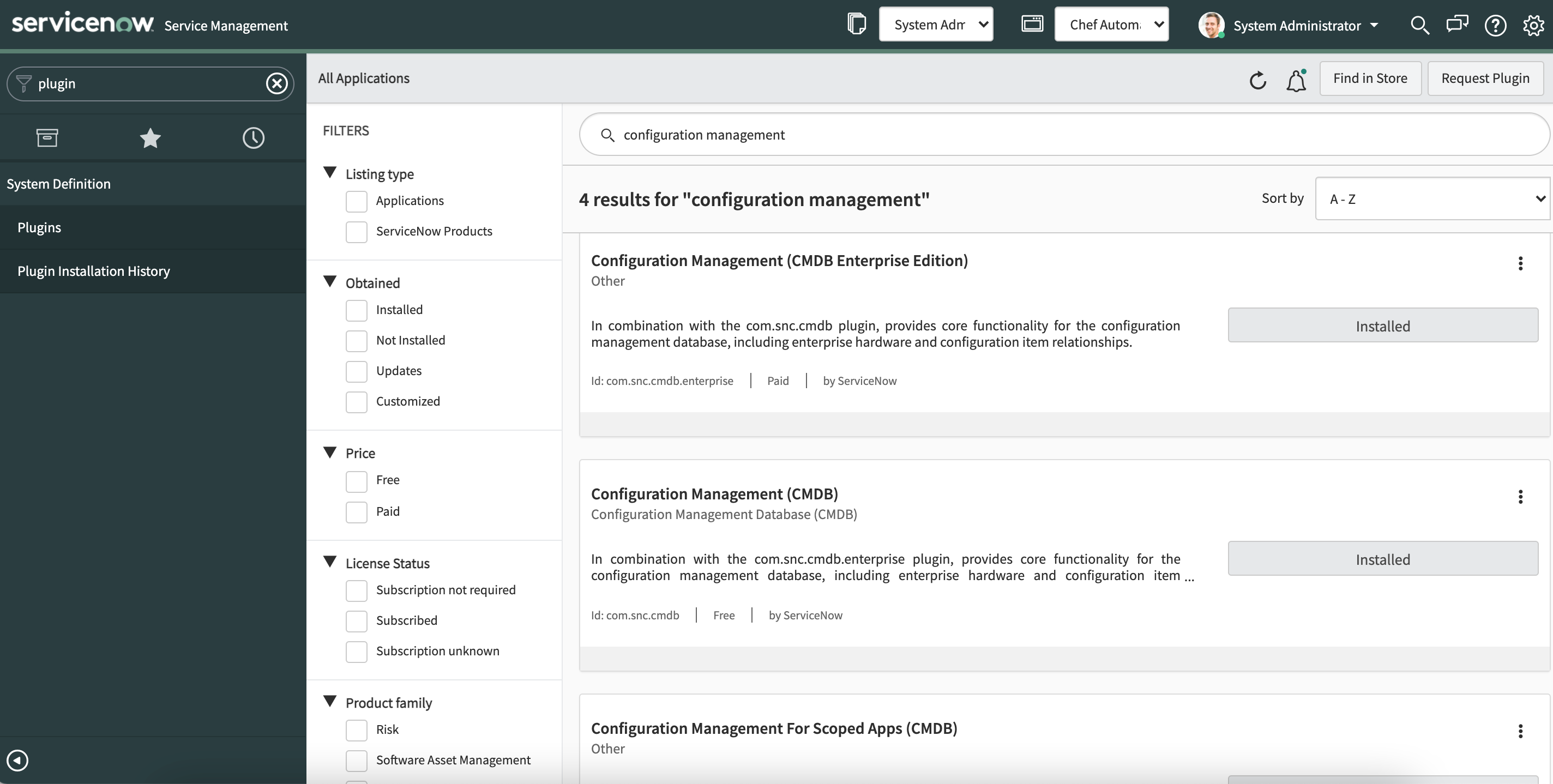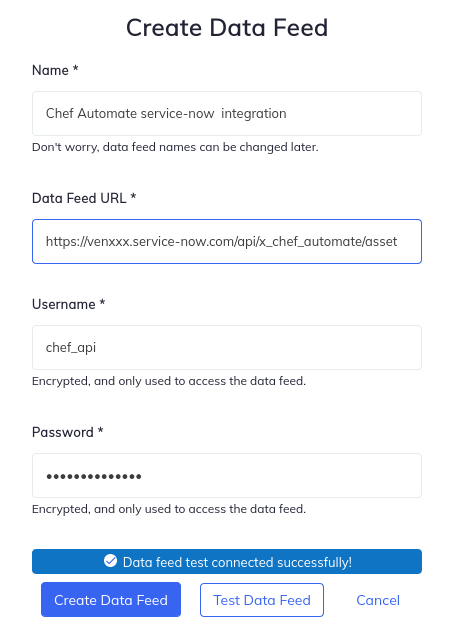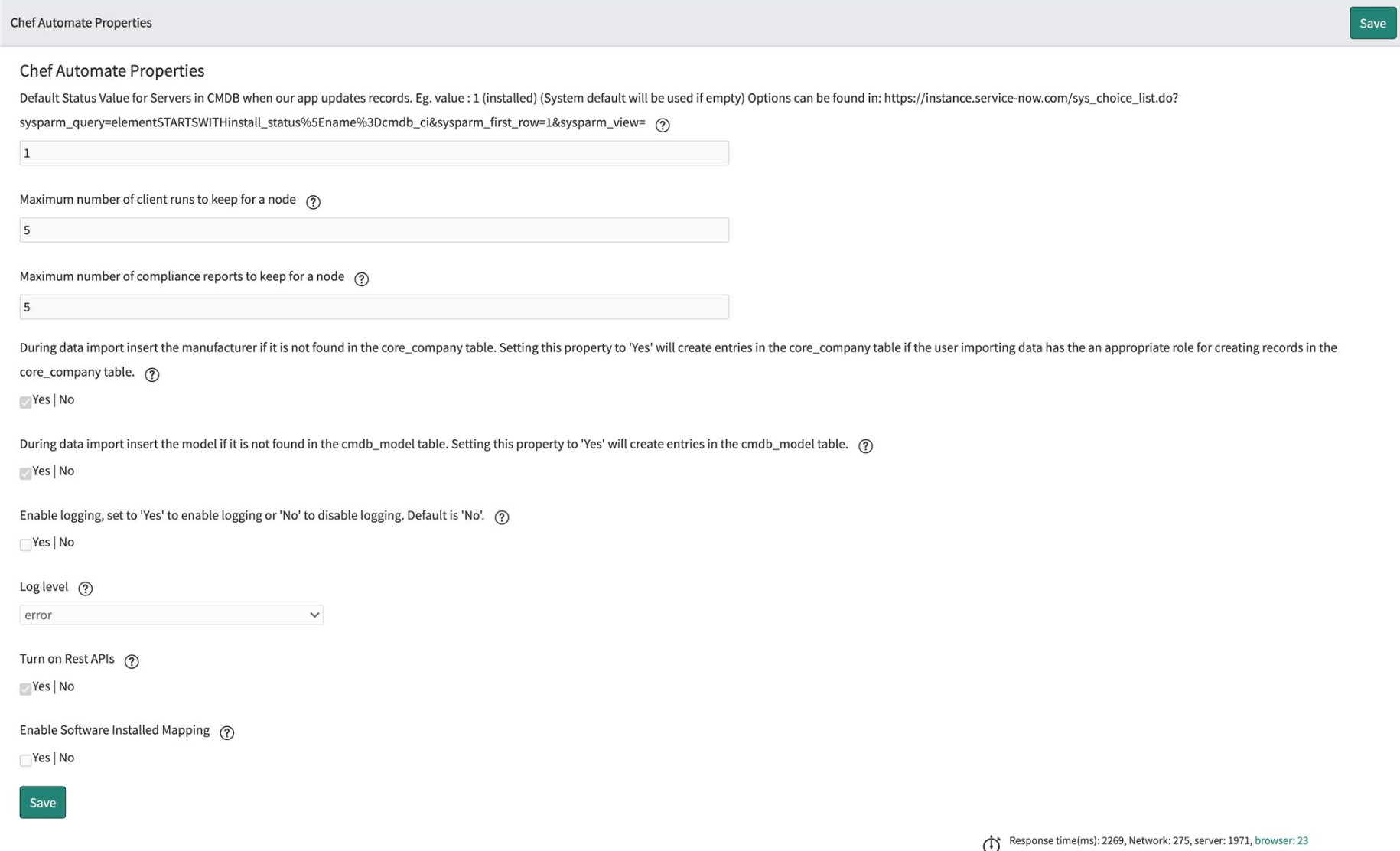Chef Automate Integration App
ServiceNow provides cloud-based services that automate enterprise IT operations. ServiceNow specializes in IT service management (ITSM) applications and provides forms-based workflow application development. It supports third-party application and data integrations. The most common integrations are for configuration management, incident management, problem management, change management, user administration, and single sign-on authentication.
The Chef Automate Integration App for ServiceNow integrates Chef Automate with ServiceNow. This app is a ServiceNow-certified scoped application available from the ServiceNow store. It integrates existing Chef Automate infrastructure and compliance functionality with ServiceNow enterprise services. Once installed and configured, this integration enables Chef Automate to create and update a ServiceNow Configuration Management Database (CMDB) with data from nodes managed by Chef Automate. Chef Automate aggregates information about infrastructure nodes, the Chef Infra Client runs, and Chef Compliance scans, helping you monitor your infrastructure in real time.

Installation
Chef Automate provides a full suite of enterprise capabilities for workflow, node visibility, and compliance. The integration between a Chef Automate server and a ServiceNow instance requires the following components:
- Chef Automate Scoped Application
- Chef Automate Server
The installation personnel performing the task of the Chef Automate Integration App in the ServiceNow ecosystem must have basic understanding of the ServiceNow system.
System Requirements
The ServiceNow instance must be reachable on port 443 from Chef Automate.
Software Requirements
- A running Chef Automate instance.
- A running ServiceNow instance.
Required ServiceNow Plugins
Install following ServiceNow plugins:
- System Import Sets
com.glide.system_import_set, min version 1.0.0. - Configuration Management (CMDB) 1.1.
- Configuration Management for Scoped Apps (com.snc.cmdb.scoped) 1.0.0.
Locate the System Import Sets, CMDB 1.1, and Configuration Management for Scoped App plugins by navigating to the System Applications > All Available Applications > All section in the ServiceNow application.

Install the Chef Automate Integration App
The Chef Automate Integration App exposes the REST API endpoint for communication between Chef Automate and the ServiceNow instance. Chef Automate sends HTTPS JSON data feeds to the Chef Automate Integration App in a ServiceNow instance to create and update the ServiceNow CMDB tables, client run, and compliance report tables.
- Navigate to the ServiceNow store at https://store.servicenow.com.
- Search for Chef Automate.
- Select the Chef Automate Integration App.
- Select Get and follow the instructions by specifying your ServiceNow credentials.
- Open your ServiceNow Service Management application.
- Select System Applications > All Available Applications > All menu.
- Find the application using the filter criteria and search bar.
You can search for the application by its
NameorID. If you cannot find an application, you may have to request it from the ServiceNow Store. - Select Install.
Assign User Roles
The ServiceNow users must have the x_chef_automate.api role to set up the ServiceNow instance to receive data from Chef Automate. Changing the Application Properties defaults requires the x_chef_automate.admin role.
The Chef Automate Integration App has three default roles:
You can assign these roles to the existing or new ServiceNow users. These roles are part of the package. If there is a need for further restrictions, you can create the required roles and controls. Also, you can associate a single user with more than one role.
The x_chef_automate.user role is suitable for those users who require application access without administration rights. To alter the system properties, you need to have the x_chef_automate.admin role.
Refer to the following pages on how to create users and assign roles in ServiceNow:
Discovery Source
The Chef Automate Integration App provides a unique ID that distinguishes between discovered Configuration Items (CIs) and imported CIs. CIs discovered by the Integration App take a value of Chef Automate by default in the Discovery Source field part of the cmdb_servers table.

Configuration
You can configure Chef Automate Integration App from your ServiceNow or Chef Automate instance.
feed_interval- The frequency in hours for refreshing the data feed. The duration between data feed refreshes is proportional to the node count, with more nodes requiring higher settings. Valid values: Any integer in the range of
2to8. Default:4. node_batch_size- The testing executed for a benchmark. The size of a compliance scan is proportional to the number of profiles applied. Scans exceeding 4MB may fail or display incorrectly in reports. Use a lower
node_batch_sizesetting to reduce the number of profiles applied in a single batch. Valid values: Between1and30. Default:15.
Configure Chef Automate from ServiceNow
Warning
Follow these steps to configure the Chef Automate Integration App from ServiceNow:
Confirm that you have the
x_chef_automate.apirole.Navigate to the ServiceNow instance.
Locate Chef Automate menu. Or, you can type Chef in the Filer Navigator text box, and the Chef Automate features display within Chef Automate menu.
Select the Automate Instances module.
Select the New button.
Enter the following details:
- Name: a unique name for the integration.
- Instance URL: URL of the Chef Automate instance.
- Automate API token: an API token generated for Chef Automate with data-feed-service authorization.
- ServiceNow user: a ServiceNow user name with ITIL and
x_chef_automate.apiroles. - ServiceNow password: password of the ServiceNow user.
Select the Test Connectivity button. The application checks that the values specified are correct and the connectivity between Chef Automate and the application establishes.
A successful test displays the service-now automate connectivity passed message. Else, an error message displays detailing the connectivity or credentials issues and help you to resolve.
Select Submit. The ServiceNow app creates the Chef Automate instance detail.

Configure the Chef Automate Integration App from Chef Automate
Follow these steps to configure the Chef Automate Integration App from Chef Automate:
Confirm that you have the
x_chef_automate.apirole.Navigate to Settings from the Chef Automate menu.
Select the Data Feeds link from Settings.
Select the Create Data Feed button.
Enter the following information:
- Name: a unique name for the Chef Automate Integration App.
- Data Feed URL: the URL of the ServiceNow application Datafeed API ending with
api/x_chef_automate/asset. - Username: a ServiceNow user with ITIL and
x_chef_automate.apiroles. - Password: Password of the user.
You must specify the fully qualified domain name (FQDN) of the ServiceNow instance to configure the Data Feed URL in Chef Automate, which has the format:
FQDN/api/x_chef_automate/asset. For example, https://venxxx.service-now.com/api/x_chef_automate/asset.Select the Test Data Feed button. The application checks that the values specified are correct and the connectivity between Chef Automate and the application establishes.
A successful test displays the service-now automate connectivity passed message. Else, an error message displays detailing the connectivity or credentials issues and helps you in resolving the error.
Select Create Data Feed.

Configure Application Properties
The Chef Automate Integration App has nine configurable Application Properties. You must have the admin or x_chef_automate.admin roles assigned to change the default values in the Application Properties.
x_chef_automate.chef.default.status- Used to set up the status of the service record as inserted or updated. Default:
1. x_chef_automate.client_runs_per_node- Used to set a highest number of clients runs for a node. Default:
5. x_chef_automate.compliance_reports_per_node- Used to set a highest number of compliance reports for a node. Default:
5. x_chef_automate.insert_manufacturer- Inserts the new record during the import if a model is not found in the core_company table by settingthe property to Yes. Default:
Yes. x_chef_automate.insert_model- Inserts the new record during the import if a model is not found in the cmdb_model table by setting the property to Yes. Default:
Yes x_chef_automate. logging.enabled- Used to flag the logging with enable or disable values. Default:
No. x_chef_automate.logging.verbosity- Debugs the data in ServiceNow. Enables the selected logging level and is visible in logs. Valid values:
Debug,Warn,Info,Error. Default:Error. x_chef_automate.Rest.api- Enables the Chef Automate API from ServiceNow. Set to
Yesto enable andNoto disable. Valid Values:Yes,No. Default:Yes. x_chef_automate.enable.system.app- Used to enable software installed mappings. Valid Values:
Yes,No. Default:No.
Follow these steps to alter the default values in the Application Properties screen:
Navigate to the ServiceNow application.
Select the Chef Automate > Properties option from the left navigation pane. The Chef Automate Properties screen appears.

Make the required changes.
Select Save.
Chef Automate in ServiceNow
Once the installation and configuration of the Chef Automate Integration App in ServiceNow completes, you can view the Chef Automate menu in ServiceNow.

The Automate Instances module allows the user to configure the integration with Chef Automate. The Server module displays a list of servers in the CMDB module.
The Chef Automate Integration App augments the existing CMDB servers and inserts new servers into the ServiceNow CMDB. The Chef Automate Integration App uses the ServiceNow Discovery IRE (Identification and Reconciliation Engine) to insert or update servers.
Chef Automate Integration App updates the CMDB file systems and software tables. It adds associated data from Chef Automate to the servers for:
- Client Runs
- Attributes
- Compliance Reports
Client Runs
You can view the data for a Chef Infra Client run by selecting a server from the list. The Client Run record displays information for:
- Client run cookbooks: cookbooks executed during the Chef Infra Client run.
- Client run lists: run lists executed during the Chef Infra Client run.
- Client run recipes: recipes executed during the Chef Infra Client run.
The complete Chef Infra Client run details are available for each server. Chef Infra Client runs are available from the Client Runs module.
Attributes
You can view the current attributes for a server by selecting the attributes record. The entire OHAI attributes are available for each server.
Compliance Reports
You can view the Compliance report detail from a server record by selecting the name on an individual Compliance report. The Compliance Report record displays related information for:
- Compliance report profiles: all profiles executed during the compliance scan.
- Compliance report results: all results from the compliance scan.
Also, you can view the Compliance report profile to display the individual results for each profile. The entire Chef Compliance Report details are available for each server. Compliance reports are also available from the Compliance report module.
Benchmarking
The Chef Automate Installation team has tested the integration of the ServiceNow app with 10K nodes of Chef Infra Client Run data. Infrastructure with more than 10K nodes may have performance issues. The system performance will decrease with other applications running in your environment.
The typical production instance of ServiceNow can have between 8-12K nodes, and will perform at +10K nodes per hour processed with Chef Infra Client run data. Benchmarking indicates that the increase in the number of nodes in the ServiceNow instance reduces the processing time.
| Client Nodes | Total Time Taken (Dev 1 Node) | Total Time Taken (Vendor 2 Node) |
|---|---|---|
| 200 | 7m48s | 4m4s |
| 500 | 17m47s | 10m16s |
| 2000 | 1h15m | 45m |
| 10,000 | 5h40m | 3h3m |
Uninstallation
To uninstall the Chef Automate Integration App:
- In the ServiceNow instance, navigate to the System Applications > Applications menu.
- Open the Downloads tab and select the Chef Automate link.
- Navigate to the Related Links section.
- select Uninstall.
Refer to the ServiceNow Integration Reference page to find information on the topics that will help you while installing and configuring Chef Automate in ServiceNow.
Was this page helpful?